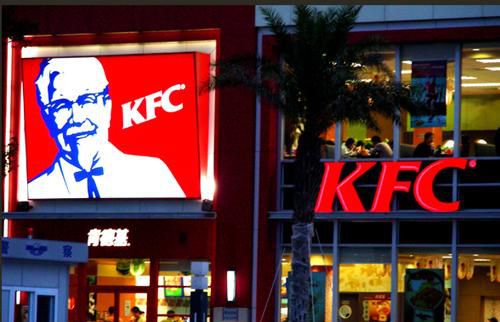肯德基被禁止在广告中使用“吃”字
|
爱思英语编者按:华盛顿消息——美国联邦传播委员会于星期二不仅发文批评炸鸡连锁餐厅肯德基最近的全家桶无骨炸鸡系列广告,而且还对这家快餐连锁巨头处以60万美元的罚款,并下令停止播放它的所有含有“错误和误导人的暗示”的广告。在这些广告中,肯德基公司暗示他们的炸鸡系列产品适于食用。
WASHINGTON—Issuing a condemnation of Kentucky Fried Chicken's recent Boneless Variety Bucket commercials, the Federal Communications Commission on Tuesday fined the fast food giant $600,000 and ordered it to discontinue all broadcasts containing "false and misleading suggestions" that its heated chicken products are intended for consumption. "KFC's claim that its fried offerings have 'that taste you'll just love to eat' is in direct violation of federal regulations," acting FCC chairman Michael Copps said. "The word 'eat' is legally permissible only in reference to substances appropriate for human consumption. Any implication that a consumer could or should 'enjoy' a KFC Crispy Strip fails to meet these standards, and presents an unlawful deception to consumers." "Any future appeals by KFC for the public to ingest its products will be met with swift legal action," he added. Working in conjunction with the Federal Trade Commission to defend consumers from what they call "blatant untruths regarding the edibility of KFC menu items," officials at the FCC have issued a list of acceptable words and phrases the restaurant can use in its television and print ads. While "eat," "feast on," and "taste" remain off-limits, the FCC has approved the use of "purchase," "be near to," "look at," and "hold."更多信息请访问:http://www.engbus.cn/ Federal officials have also placed strict regulations on what actors within the ads can be shown doing with the breaded objects, so as to reduce the risk that viewers may become confused and attempt to ingest a KFC Snacker. In keeping with the false advertising subchapter of the FTC Act of 1914, the fast food chain is prohibited from setting its commercials in a kitchen, dining room, or any space generally associated with the act of eating. It is also not permitted to show people chewing, rubbing their stomachs contentedly, or exiting a bathroom stall with a look of relief that suggests they have digested the product. Utensils of any kind are also expressly forbidden, even when held by an animated character. "At no point should these commercials depict persons willfully placing KFC items anywhere within the designated 'eating zone,'" said Copps, referring to the federally defined area extending in an 8-inch radius around the mouth. "Nor should individuals be seen manipulating the chicken in a manner that may bring it into contact with their lower facial region, or the lower facial region of a child or companion animal. In fact, children under the age of 8 are not allowed to appear in the ads in any form." In compliance with the FCC's orders, KFC executives have pulled the offending ads from television airwaves. "We are cooperating fully with the federal government to ensure all our future ad campaigns comply with official guidelines," KFC spokesperson Mark Dunn told reporters before conferring briefly with FCC agents. "Remember, we still offer many great-looking, purchasable things—such as our Extra Crispy legs and wings—and we invite everyone to come on down and obtain them for whatever use they deem appropriate." KFC advertisers are reportedly still in negotiations with authorities over whether the word "consumables"—a term that can encompass any product that must be replaced periodically, such as brake pads or swimming pool chlorine—is an allowable substitution for "food." In the meantime, the restaurant chain has begun work on a series of commercials for its new Honey BBQ Boneless Wings. An early cut of the first TV spot features grainy, black-and-white footage of stylish automobiles, lush forests, people standing at a safe distance from a KFC bucket and smiling, chicken being slaughtered, and a gallon of barbecue sauce being slowly drizzled over a fire. |









